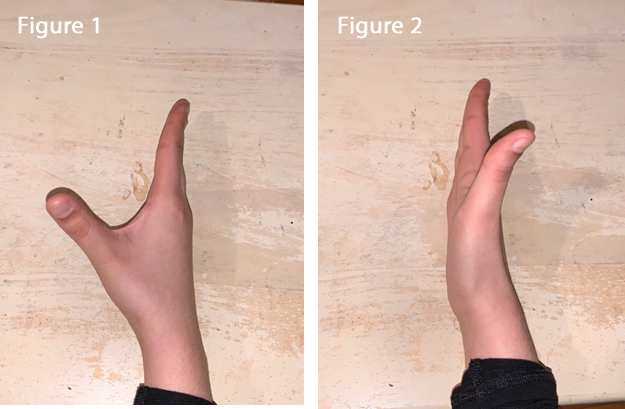Editor’s Note: “The Paksima Sign“. The honor of featured article is given to Neil Gambhir and Dr. Nader Paksima for their original work on a well-known condition. Dr. Paksima, a tireless educator and strong supporter of the AOAO, along with Neil Gambhir are to be congratulated!
By Neil Gambhir BS and Nader Paksima, DO
First described by Dr. Fritz de Quervain in 1895, De Quervain Tenosynovitis is one of the most common pathologies that hand surgeons encounter today. The condition is characterized by thickening of the tendons within the first dorsal compartment of the hand, namely the abductor pollicis longus (APL) and the extensor pollicis brevis (EPB)1. The function of the APL is primarily extension of the thumb metacarpal (not abduction) and the EPB’s function is extension of the MP joint. Patients with De Quervain’s experience pain throughout the radial aspect of their wrist that is worsened by thumb and wrist movement. This condition is classically seen in new mothers and in those who frequently text message2.

Figure 2: Hand with De Quervain Tenosynovitis, concomitant adduction and extension are seen
Diagnosis is made clinically via the Finklestein test which involves the examiner inducing ulnar deviation of the wrist while the thumb is flexed into the palm on the affected side, thereby pulling the tendons of the APL and EPB through the tight sheath. The reproduction of pain is considered a positive test and is pathognomonic of the presence of De Quervain Tenosynovitis3.
Through clinical examination, we have observed a physical exam finding that may aid in the diagnosis of De Quervain’s Tenosynovitis. We have observed that patients afflicted with this tenosynovitis markedly adduct their thumb upon attempted extension (Figure 2). We postulate that this abnormal motion of the thumb occurs due to the use of the EPL to extend the thumb metacarpal instead of the APL. The EPL has an adduction moment and so the thumb extends and adducts. Patient will avoid activating the APL and EPB to extend the thumb due to pain. In effect, this is the opposite action of the Finkelstein test. This maneuver may help make the diagnosis of De Quervain’s tenosynovitis in patients who are unable to complete the Finklestein test or who have an unclear presentation.
References
- Allbrook V. ‘The side of my wrist hurts’: De Quervain’s tenosynovitis. Aust J Gen Pract. 2019 Nov;48(11):753-756. doi: 10.31128/AJGP-07-19-5018. PMID: 31722458.
- Ali M, Asim M, Danish SH, Ahmad F, Iqbal A, Hasan SD. Frequency of De Quervain’s tenosynovitis and its association with SMS texting. Muscles Ligaments Tendons J. 2014;4(1):74–78. Published 2014 May 8.
- Som A, Singh P. Finkelstein Sign. [Updated 2019 Mar 24]. In: StatPearls [Internet]. Treasure Island (FL): StatPearls Publishing; 2019 Jan-.


